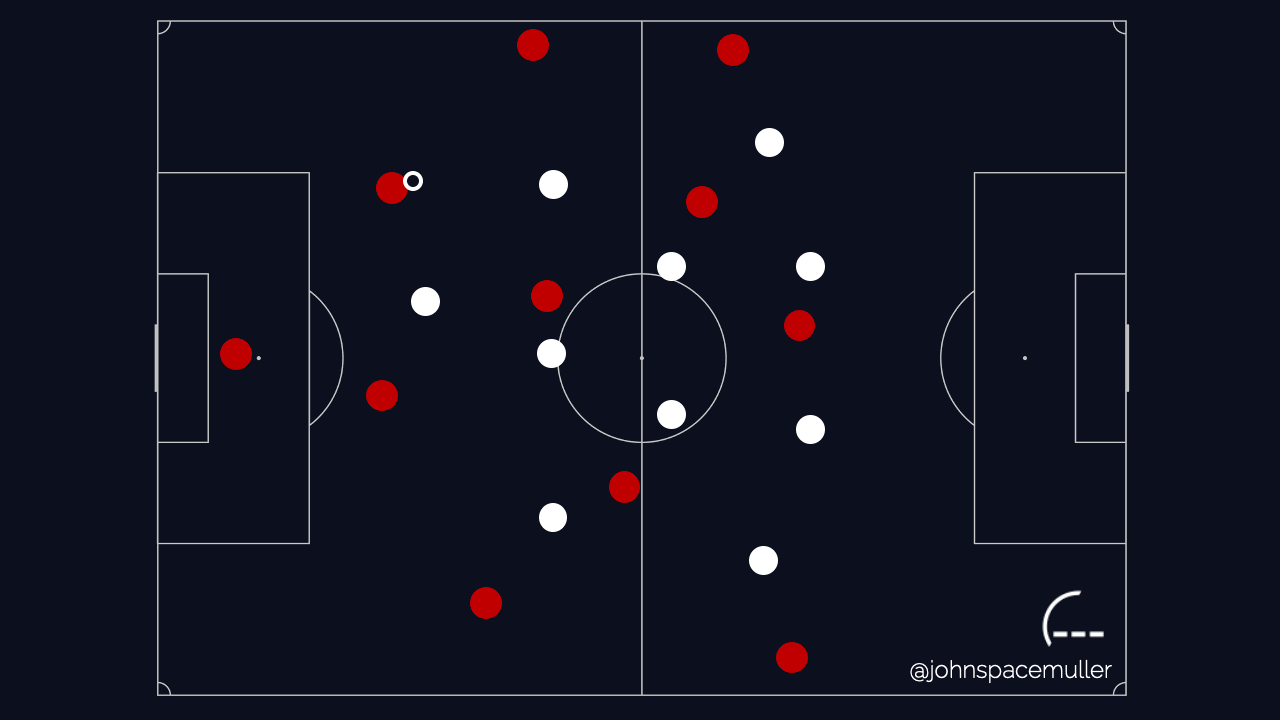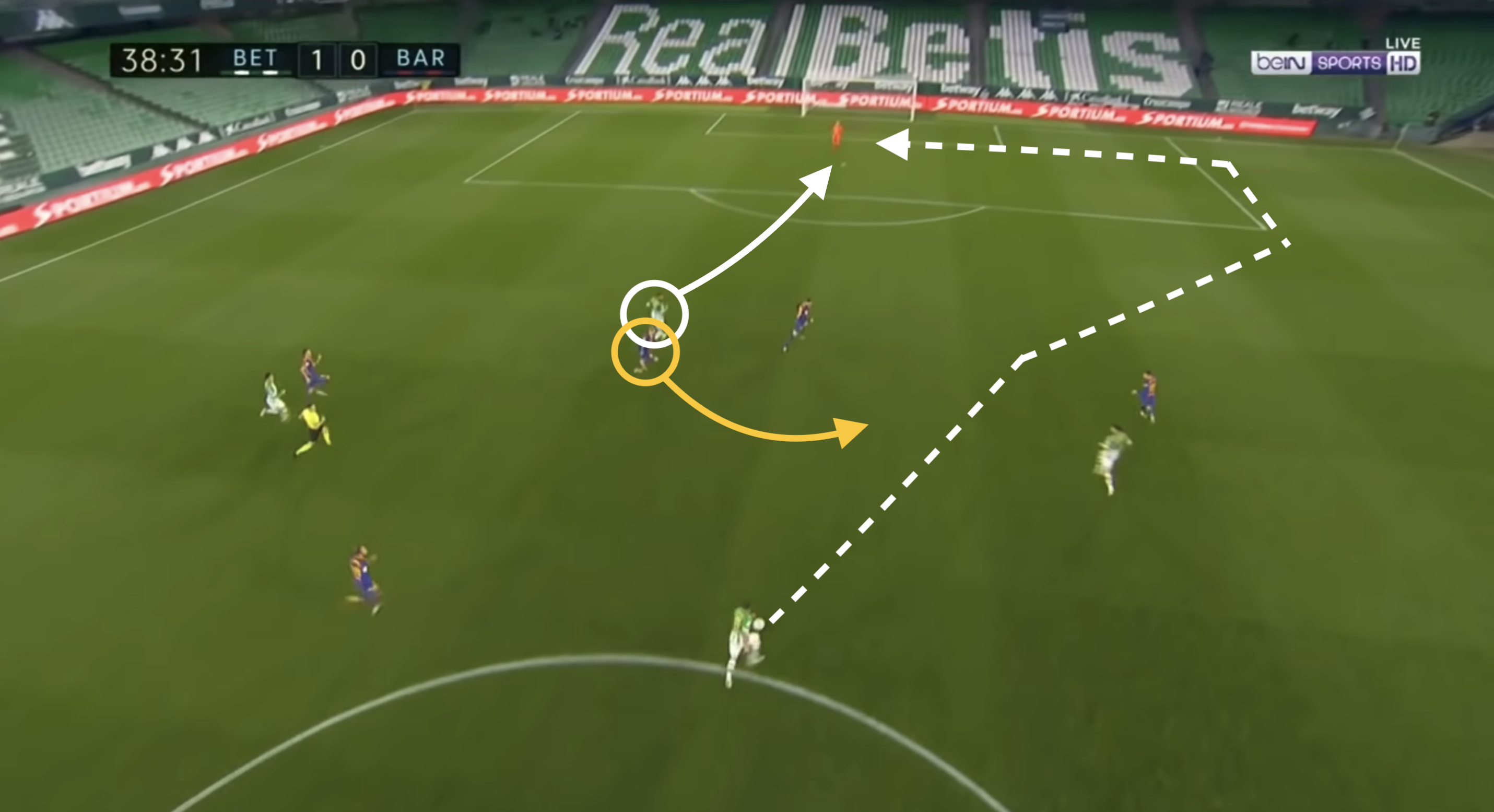
There are three Frenkies, and none of them can save Barcelona.
For a minute there it looked like our story might have a happy ending.
True, the hero was face down in the dirt, but he ate shit triumphantly, like a champion. Frenkie de Jong dusted himself off and walked coolly back to midfield, giving little nods to his teammates as the ref pointed to the spot. The penalty was converted. Holland’s golden boy, the player FC Barcelona spent lavishly on to lead them into the future, had given his team the lead against Paris St. Germain in the Champions League knockouts.
There are five problems with this story, and most of them are Kylian Mbappé. When the final whistle blew, Barcelona had lost 4-1, the club’s worst defeat at the Camp Nou in the history of the Champions League. Which, sure, ugly games happen, but this one came just six months after de Jong’s team flamed out of last year’s tournament with a quarterfinal against Bayern so catastrophic it earned its own Wikipedia page to commemorate Barça’s most lopsided loss in 69 years.
This all ties in to the fifth problem: What the hell was a defensive midfielder doing drawing a penalty in the first place? Not what Barcelona signed him to do, that’s for sure. There are three Frenkies, three different players in distinct roles. We saw them all against PSG, and they all came up short. It’s time to ask a question the world has been kicking down the road for years, ever since we fell in love with a lanky young dribbler at Ajax.
What if Frenkie de Jong just isn’t that good?
The First Frenkie: Ball-Carrying Pivot
Back when he was coaching the Netherlands, Ronald Koeman was sure he knew how to fix Barcelona. “You invest in a young player for whom you pay a lot of money. Then you have to let him play in the position where he has the expected return you get from him,” Koeman said when he took the Barça job, explaining for the umpteenth time that de Jong is best in a double pivot. “He has shown that at Ajax and the Dutch national team. He will also play there at Barcelona.”
It was so obvious that Koeman couldn’t believe his predecessors had missed it. He immediately rearranged Barcelona into a 4-2-3-1 so that de Jong could have the left defensive mid spot he’d played for Koeman’s Oranje. It was the role he’d starred in during Ajax’s Cinderella Champions League run in 2019, the one that cemented his status as the most coveted midfield prospect in Europe. “I really think he is a revelation,” the Toetalvoetbal-era Dutch midfielder Arie Haan said. “You might laugh, but he is a better version of Franz Beckenbauer.”
The Kaiser comp makes sense in light of de Jong’s most unique skill, his marathon carries from the back line into midfield. He loves to drop for the ball outside his center backs and sprint forward as far as athleticism and the element of surprise will carry him, handing the baton to an open teammate just as he’s dragged down. The writer Kees van Hemmen dubbed these moves “artificial transitions” for the way they scramble defensive lines, taking the buildup from a standstill to a fast break in a matter of seconds.
One important thing to know about Frenkie’s Hollywood runs is that they’re most dangerous in the left halfspace. There’s more room to operate off to one side than in the middle, and as a right-footed dribbler he’s more comfortable laying the ball off to his left, up the wing that defenders leave open when they squeeze in to stop him. Nearly half of de Jong’s 36 progressive carries this season have ended in that second vertical fifth of the field, where his diagonal outlet passes help keep the play’s momentum going. It’s the only zone where his Beckenbauer impression moves Barcelona closer to goal two subsequent actions after the end of the pass, a sign of an effective artificial transition:
Problem is, he rarely plays on the left anymore. Since the turn of the year de Jong has started 11 of 14 games in Barcelona’s midfield and played on the right in all of them to give the team a better balance. That’s limited his progressive carries, robbing him of his one midfield superpower. I’m sure Clark Kent was a good reporter and all, but he’s not going to save the world without a phone booth.
Three times against PSG, de Jong collected the ball near his own penalty arc and tried to fast-track the buildup with a vertical carry. One time he headed for the left halfspace, but Leandro Paredes saw it coming and stepped over to help Marco Verratti trap the play against the sideline. Too predictable. Once he went right, and a little Messi magic almost turned it into a shot. The best one was when de Jong dribbled a giant question mark across the face of PSG’s midfield, then slipped behind Paredes to get the ball back between the lines. A short roller straight ahead would have put Antoine Griezmann in on goal, but de Jong opted for a flashy scoop with the outside of his right boot. Turnover.
The play highlighted de Jong’s biggest problem: he makes decisions with the blazing quickness of continental drift. It’s why despite his technique he’s not a very incisive passer. He broke lines just once against PSG and averages fewer progressive passes per 90 than every Barcelona midfielder except 18-year-old Pedri. His decisions don't help the risk-reward case for using him as a deep playmaker. In the eleventh minute against PSG he dropped to receive under pressure and should have dumped it to an open Clement Llenglet. Instead he tried to turn and play an adventurous outside-of-the-boot pass that Pedri couldn’t control. Turnover again, followed by a white-knuckle counter into Barcelona’s box.
But if de Jong isn’t asked to carry from deep and doesn’t add much with his passing, where does that leave him? A 32-year-old Sergio Busquets held together with string and Scotch tape is beating Barcelona’s 23-year-old starlet in every passing stat while doubling his defensive output. Even Pedri has twice as many pressures and tackles per 90. De Jong attacks like a defensive midfielder and defends like an attacking midfielder, which is the opposite of how you’d hope for that sentence to read. According to Mike Imburgio’s DAVIES model, de Jong is probably worth about as much to his team on the ball as Miralem Pjanić, a veteran who only joined Barcelona as a makeweight in some accounting shenanigans.
Longtime Barcelona observer Kevin Williams saw this coming. While everyone else was clamoring to bring de Jong to the Camp Nou, he called it a “fantasy ... that De Jong will be able to replicate his open-space frolicking with Ajax in the compressed, pressure-packed, physical areas in which players such as Sergio Busquets thrive.” Busquets, he wrote for The Athletic when this was still true, could “watch a play develop, understand where to be, move to that spot, intercept the opposing player, take the ball, already know where the ball needs to go next, then make that pass. There is no next Busquets because Busquets is a warlock.”
The Second Frenkie: Box-Crashing Midfielder
De Jong may not be the next Busquets, but with a little luck he might be the next Paulinho.
Ever since they swapped out Xavi for Arda Turán—which, yes, is a thing that more or less happened—Barcelona has reserved one midfield spot for a physical veteran whose job is to cover for Messi and get stuck in as much as possible. Over the last few seasons, Paulinho and Arturo Vidal refined the role into a midfield-forward hybrid who pressed hard, arrived in the box to score goals, and did pretty much nothing else. The beauty of the gig was its minimalism. You didn’t have to be a world-beating talent; Barcelona had plenty of those back then. You just had to work your ass off.
After his new 4-2-3-1 melted into a gelatinous blob, Koeman started to wonder if maybe Ernesto Valverde and Quique Setién weren’t as dumb as he’d thought. In December he switched to a 4-3-3 with de Jong as a right center mid—exactly where Valverde had used him—and things seemed to click into place. But this wasn’t Barça’s old 4-3-3. With no Luis Suárez to occupy the center backs, Messi returned to the false nine role he hasn’t played since he was younger, quicker, and not the only guy on his team who breaks lines. In this new system it’s fallen to de Jong as the most mobile midfielder to get up there and lead the line, like so:

That’s what he was doing when he drew the penalty against PSG. He’s scored a few goals like this during a six-week stretch of weak opponents. It’s been enough to get a redemption narrative going for a player nobody was ready to call a failure, least of all Ronald Koeman. “I believe he is more complete now than at Ajax,” said his doting Dutch coach, who’d been so sure a few months ago that de Jong just needed to get back to Ajax self. “He can still help Busquets to construct the play, but his arrival in the box helps us to create more and score more goals.”
Does it though? According to FBref’s Statsbomb data, de Jong is averaging 0.17 non-penalty expected goals and assists per 90 minutes in his new attacking role, which is somehow lower than his season average even though it includes one goal he “shot” when the ball was already halfway over the line. If you add in the pass before the final ball, he’s averaging one shot-creating action per 90’ in those games—again, just half his season average and about on par with Barcelona’s center backs. Those numbers are nowhere near what a team like Barça needs from a part-time striker. It’s only a third as much NPxG+xA as Paulinho produced during his brief stop in Barcelona, and he played a lot more defense while he was at it. If the future of your superclub has “Paulinho that one year between China stints” as his ceiling, you probably need a new future.
The Third Frenkie: Free Center Back
There’s one more possible version of de Jong, the freewheeling center back we saw in the closing minutes of the PSG blowout. He’s played some version of it in Barça’s last three league games, mostly out of necessity, but if you strap on some medical-grade rose-colored glasses you can sort of see a future for him there. This is a guy who’s best when the game is in front of him, and playing as an auxiliary center back for Barcelona could, in theory, put his carrying and physicality to good use without requiring all that much honest-to-god defending. (If you watched de Jong lose Kean for a free header on PSG’s third goal, you’ll know that last part is mandatory.) Maybe he’d fit in on the left side of a back three, where he played a little against Athletic Bilbao the other week?
As for his actual track record as a central defender, it’d be churlish to fault CB Frenkie for not cutting off the angle to Mbappé on PSG’s fourth goal, a three-on-two fast break that he would have had to read perfectly to stop. So let’s just say he played that one a lot better than a similar counter from Betis earlier this month that made former Barcelona player and sometime cartel associate Rafa Márquez tweet his frustration: “The downside of not playing with a natural center back 🤷🏻♂️ takes a bad defensive angle and leaves the free space where the forward takes advantage to finish easily.”

Rafa’s right, of course. De Jong isn’t a natural center back. He’s not a natural forward either. As a midfielder he’s been pretty unexceptional, despite getting the most minutes and second-most freedom on the team after Messi. With all three competitions slipping away, it’s getting to be about time for Barcelona to start thinking ahead to next year. If Koeman can’t figure out what de Jong is good at, at least Riqui Puig is still hanging around, patiently waiting his turn to be the golden boy. ❧
In case you missed it, I did a little followup video on Monday's progressive passing letter:
Progressive pass data in action: https://t.co/rtW3Gk17eV
— John Muller (@johnspacemuller) February 18, 2021
Further reading:
- Ryan O’Hanlon, Frenkie is the Future (The Ringer)
- Kees van Hemmen, Frenkie de Jong, Ajax, and Artificial Transitions: Reverse Engineering Insights on Turnovers (Below the Radar Analysis)
- Kevin Williams, Barcelona fuels PSG rivalry with misguided pursuit of Frenkie de Jong (The Athletic)
- Dermot Corrigan and Mark Carey, This is not the De Jong we saw at Ajax – he is more attacking now, more complete (The Athletic)
Image: Wallerant Vaillant, Portrait of a Boy with a Falcon
Sign up for space space space
The full archive is now free for all members.